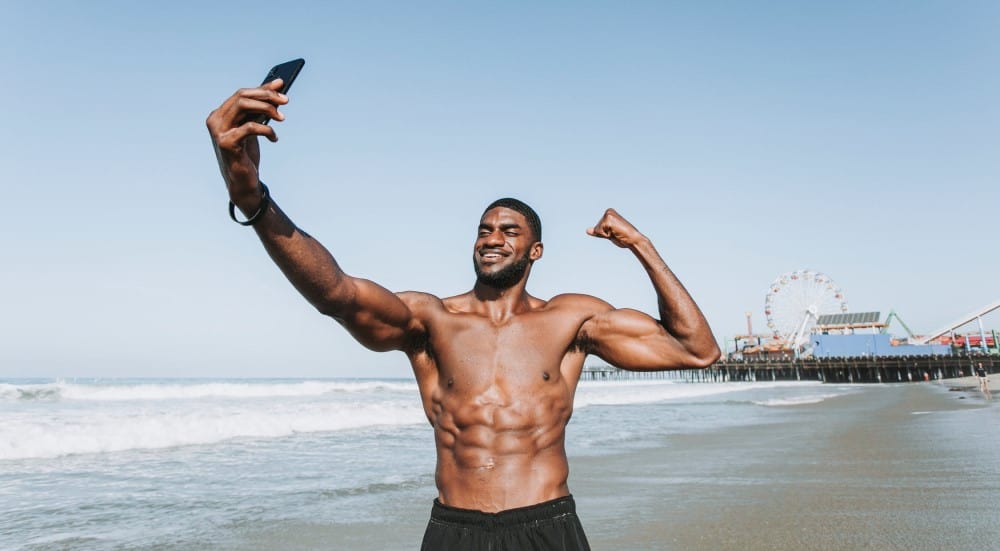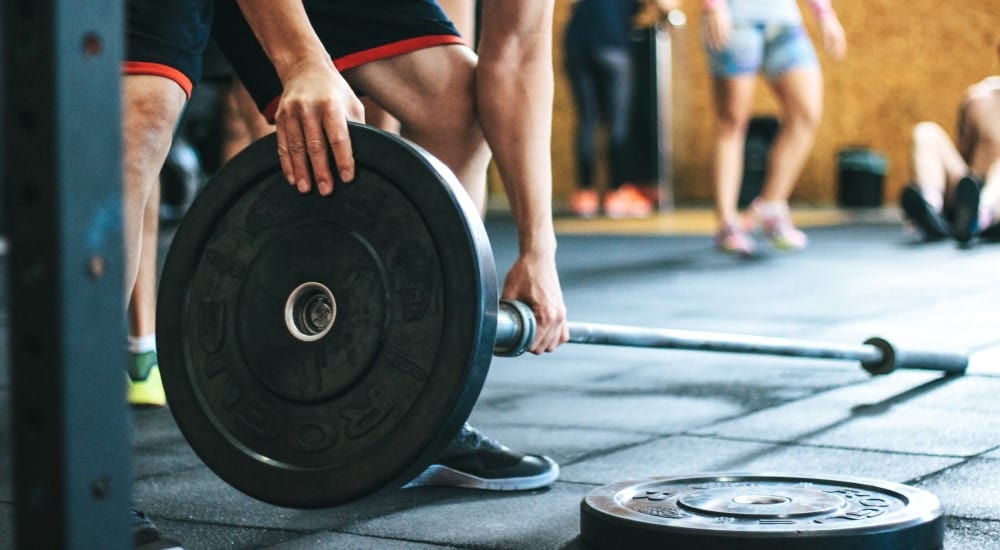Let’s face it,
apart from a variety of other benefits, most of us, including myself, started hitting the gym for the one big reason. Can you already guess it?
Right, aesthetics!

Whether losing some extra pounds, working towards your summer body or improving your general appearance; we all know how motivating the results from our training efforts can be, once they become noticeable.
Especially during the first months it appears to be incredibly easy to achieve good progress.
Unfortunately, our muscles get used to the strain over time and further progress requires increasing commitment.
But what if you are putting all the commitment in the world to suddenly realize that you might not reach the body you are aiming to achieve because of a developing imbalance between your muscle groups?
Muscle imbalance either occurs as an asymmetry between the left or right side of the body or as an imbalance between a muscle and its counterpart.
Both can be extremely frustrating. While asymmetries might not look very well, other imbalances can cause pain, lead to false posture and injuries, negatively affecting training progress and general life quality.
Also keep in mind the impact, poor posture has on aesthetics.
Some people say muscle imbalances are mostly connected to genetics, others relate it to flawed training techniques.
Both can but does not have to be correct.
What I can tell you for sure though, is that you are not alone, and you have quite some possibilities to get your muscle imbalance under control!
Muscle Imbalance and its Causes
Before I am going to talk about the best ways to cope with your muscle imbalance, it is important to understand that muscle imbalance is not always the same.
If muscle imbalance occurs as an asymmetry between the left or right side of the body we talk about it as a muscle asymmetry, for example when the right bicep has a higher volume than the left one.
The other typical form of muscle imbalance develops between one muscle and its counterpart. It can occur almost anywhere. A very common form of this muscular imbalance could be a strong chest opposite to a weaker back.
Asymmetry
Physical symmetry is a beauty feature. As with almost everything in our environment we perceive symmetry as attractive.
For that reason, it can be especially frustrating when dealing with muscle asymmetry – I have been fighting with a slightly bigger right chest for years and knowhow it feels like.
Smaller asymmetries or those involving back muscles can sometimes be hard to detect but a distinct asymmetry can usually be noticed easily as most of us regularly throw a critical look into the mirror.
“A fully symmetric body is impossible to achieve”
Genetics
Spotting a muscle asymmetry, you should know that it is almost impossible to achieve an entirely symmetrical body. Disparities in our body structure are absolutely normal.
Think of our organs! While the heart is located more to the right, our liver sits slightly left.
It happens to be the same with our muscles.
Most people have an asymmetric six pack and neither, hard training nor the best diet are going to change that. Instead, tendons cross our abdominal muscle, forming each six pack individually, just as other asymmetries can be genetically predisposed.
Thank your parents.
As we are usually a lot more critical about our own body, it might also happen that we notice details, others would never see. Unrealistic role models such as fitness models, presented in the right angle or even photoshopped, can easily reinforce this habit.
Being critical is good, just do not be over critical.
Habits and environment
Apart from genetics, asymmetry can be a possible result of our job or habits.
It is not unusual that a right-handed person’s upper body is better developed on the right. Job-related, repetitive movements can also contribute to asymmetric muscle development.
Working as a waiter next to my studies, my left bicep (the one that carried every single plate and tray) is slightly bigger and stronger.
Other habits or environments can lead to a change in posture that may result in incorrect execution of exercises.
The dominant side does most of the work
When an asymmetry develops, the dominant muscle is likely to do more work which can enhance the imbalance even further.
Agonist and antagonist: Every muscle has its counterpart.
Next to an asymmetry, a muscle imbalance can also develop between a muscle and is counterpart, agonist and antagonist. Both muscles are attached to the same joint and pull in opposite directions. When one muscle contracts, its opponent stretches and the other way around.
At the point where muscle shortening, muscle attenuation or overdevelopment disturbs the balance between agonist and antagonist, we also talk about muscle imbalance.
Factors that contribute to this kind of imbalance have a variety of origins. They relate to our lifestyle, including little physical activity, unnatural postures, and movements when practicing a job, hobby or habits as well as heavy physical activity or training.
If a muscle is flexed frequently, it adapts and gets stronger. However, tension in the muscle also increases and pulls with higher force at the joints. Even during rests, when it should not contract.
Consequently, on-sided muscle strain is the leading cause for muscle imbalance mostly related to a lack of physical activities, overuse, and repetitive movements or poor posture.
Lack of physical activities
Most of us spend a lot of time seated. While sitting, our hip flexors are being flexed which can result in shortening of our hip flexors and later be a source of lower back pain.
There is nothing wrong about sitting. Depending on your job, it can even be hard to avoid but do your body a favor and take some breaks in between.
Overuse and repetitive movements
Overuse and repetitive movements of a muscle are common to develop muscle imbalance. The tennis elbow is one typical example, involving both factors. Most of the time, a connection can be drawn to job or hobby.
Training with a one-sided focus on particular muscle groups only will have the same effect and might even be more fatal.
Stretching
Associated with physical activities is the stretching component. Regular contraction of a muscle will in the long-run lead to shortening if you avoid stretching.
Posture
To name another cause, bad posture can lead to muscle imbalance as well. How often have I been told to sit straight as a kid!? And my parents were right.
Think about it this way, posture is the position we stay in for most of the day.
Bad posture weakens the postural muscles that normally sustain posture which can have a huge impact on especially our upper body.
When the postural muscles are not strong enough so that phasic muscles, normally controlling movement, have to step in, muscle imbalance arises.
Habits and environment
Wearing shoes with heels is just one of many habits that can contribute to muscle imbalance. Poor or abnormal posture, lack of physical activities, muscular over use, flawed training techniques and any other causes previously mentioned might be habitual and sometimes hard to change.
Consequences of Muscle Imbalance
While a muscle asymmetry is more of a beauty flaw, an imbalance between agonist and antagonist can result in a variety of negative consequences.
Poor posture as a result of muscle imbalance can reinforce muscles to shorten or stretch further, worsening the entire situation. Dominant muscles are generally disposed to take work from the under developed ones. A hollow back, hunchback or spinal curvations can arise.
Muscle imbalances are the main cause of physical malposition that can induce pain in any region of the body and increase the risk of injury. The unfavorable strain distribution affects the joints, can cause premature attrition on the articular cartilage and overstress the tendons. Common spots are those that experience a lot of movement such as shoulders, hips and the area around your spine.
If you sense pain that could be a result of muscle imbalance, I highly recommend you to see a professional as it very unlikely to cure distinct imbalances and prevent injuries without specific treatment.
Ways to Prevent Muscle Imbalance
Before thinking about how to fix your muscle imbalance, you should consider your opportunities to prevent your body from them!
The first thing to start with is a brief analysis of your job, hobbies and lifestyle.
Do you sit a lot? Do you regularly execute heavy physical exercises? Are any of these exercises related to one-sided or repetitive movements? Do you work out? Do you stretch?
On the basis of these questions, it is often already possible to define areas that will sooner or later become problematic if you do not take counter-measures.
The first tip addresses each of us and relates to our posture. Good posture needs to be practiced, whether sitting or standing.
The following steps will help you to take an upright posture:
- Raise your sternum (chest bone) up-forwards
- Keep your head relaxed and upright
- Slightly flex your abdominal and gluteal muscles to avoid a hollow back
- Slightly erect your pelvis
- Slightly bent your knees, do not stretch out
- Keep your feet about hip-width apart
An upright posture while sitting might not always be easy to maintain but is also possible.
As it is extremely easy for most of us to fall back into old patterns, I recommend the following:
Take a large towel, roll it together and place it on your seat. Make sure to place your sit bones exactly on a towel. Sit bones are the bones that you feel when you sit on your hands. It will help you to keep your pelvis in the correct position.
My posture while sitting is usually horrible but the towel beneath my butt cheeks while writing this article helps a lot – you will know what I mean!
Take walking breaks every two hours at the very least.
Become aware of overuse and repetitive motions during your job or free time activities.
Identifying them will help you to come up with slight changes that stress other muscles of your body to prevent overuse. On-sided motions for example in technical professions can be difficult to balance. Targeted training can contribute to even muscle development.
Implement multiple joint exercises into your training
Nothing speaks against integrating exercising on machines into the training. However, if you exercise intensively, you should start with free multiple joint exercises, even if it takes more time to learn them.
Why is that?
Multiple joint exercises exercise your body in its natural functions. Instead of isolating certain muscles with machine-training the respective antagonist is needed for stabilization. If you always pay attention to correct execution, you train the musculature in a way that favors just this attitude.
Do not get me wrong, machine exercises as others that isolate certain parts of the body can be great to counter asymmetries. I simply recommend them to be rather additional than forming an entire training.

Practice your mind-muscle connection during workouts
You might have already heard about the mind-muscle connection that describes the ability to feel your muscles working. Developing this ability will not only help you to prevent your dominant muscles from doing more work. It will also help you to isolate specific muscles during your training for better muscle growth.
Especially as a beginner I recommend using light weights during your workouts. Lifting heavy might look impressive but there is absolutely no need to train with max weight in the first couple of months.
Your muscles need to get used to heavy loads anyways, pay much more attention to a clean execution of every single rep instead. Check your execution in a mirror, ask your partner or gym staff.
Once wrong execution becomes habitual it can be hard to reprogram your body.
My personal advice: Get used to free barbell exercises as early as possible. To prevent or balance asymmetries consider switching to free dumbbell training.
Stretching
I hate it as much as many others but stretching might be the most underestimated component when exercising!
I have already explained it but it can not be said often enough. Regular muscle contraction will automatically lead to muscle shortenings if you skip stretching. Even 5-10 minutes of stretching after every training are going to make a big difference! Do yourself the favor.
How to Fix Muscle Imbalance
You now know how to prevent muscle imbalances but what if it is already too late?
You have noticed an imbalance.
As a next step I recommend you to determine all muscles involved which can but does not necessarily have to be easy.
Decide whether you are facing one muscle being stronger than its counterpart or an asymmetry. The two kinds require different approaches in order to get back into balance.
The one thing they do have in common though is the time component:
Be patient!
I know it is a pity – unfortunately, our muscles need time to grow and it is just logical that compensating muscle imbalance does so, too.
Muscle imbalance
Use isolated exercises to target the weaker component, causing the imbalance
As soon as you notice the imbalance andspotted the underdeveloped muslce(s) adapt your training. Add exercises that isolate the underdeveloped muscle while cutting on those, training the stronger muscle.
Keep in mind that overtraining inverts effectiveness!
Get used to more multiple joint exercises as part of your training
If you are used to a lot of machine training and other isolation exercises it can be difficult to train your body evenly.
Multiple joint exercises ensure attention to be drawn on a muscle and its counterpart and those, stabilizing your body during the exercise.
A great way this can be accomplished by are all kind of barbell exercises.
Add variation to your routine
Many of us have quite a narrow training routine.
Getting used to certain exercises is very common as execution becomes easier over time. You might say it is not a bad thing but more variation between exercises will not only ensure all muscles of your body to be trained more evenly. It is also going to set new impulses to your muscles that are very likely to further stimulate muscle growth.
Focus on your weak points
Variating your training be aware that we all have our personal preferences of exercises and muscles we like to train.
A technique that helped me to overcome my personal preferences, stopping my subconscious mind from influencing my routine is the focus on weak points.
Train your weaker muscles first! At the beginning of your training, your motivation and stamina are at their peak – Best conditions to defeat the imbalance!
Posture, posture, posture!
Bad posture accompanies many of us. Get rid of it by reminding yourself in retaining good posture as often as possible.
It is incredibly easy to forget about it, luckily there are ways to remember. Keep sticky notes at common areas you spend a lot of time at is just one way. Be creative!
Asymmetry
Correct execution of the exercise
False execution of exercises can result in unequal muscle strain. Check your own execution in the mirror, ask your partner or the gym staff. You might also want to doublecheck if your own perception of an exercise’s “correct execution” is right. Continuously train your mind-muscle connection.
Be aware of superficial knowledge
Not everyone who pretends to know something is right, always keep that in mind!
Exercise with dumbbells
Dumbbells are another great form of multiple-joint exercises, the may even need more stabilization. At the same time, you prevent the stronger muscle from doing more work.

Keep the training volume equal or shift its balance towards the weaker side
Let your weaker muscle set weight and reps to align it with the stronger one. More reps on weaker- and fewer reps on the stronger side can accelerate progress. Be again aware to avoid overtraining.
One possible example would be to start the first set of an exercise with just the weaker side. Add the stronger side in the second set and match the volume to the stamina of your weaker side.
To sum it up
It is totally normal that all of us have their personal strength and weaknesses, but everyone can individually adapt their activities to it.
Regardless of all efforts, muscle imbalance can always occur. Make yourself aware of what type it is, which muscles it involves and find out what countermeasures help you best.
Adjusting two different muscle parts takes a lot of patience. It may take months before you can really notice the results. Therefore, I can only emphasize a focus on regular and long-term training with a targeted, but well-dosed increase in intensity for the weaker part.
What imbalance do you face and what helps you best?
Cheers,
Chris




